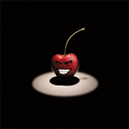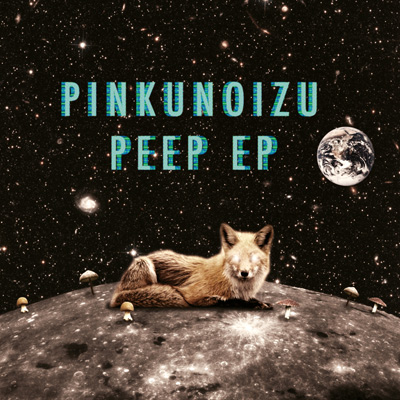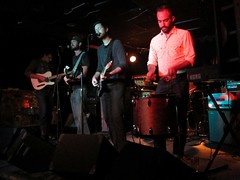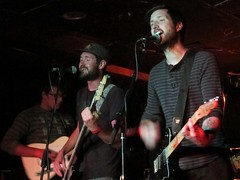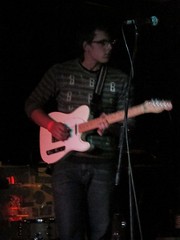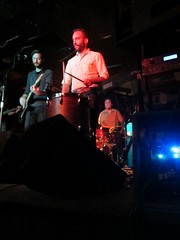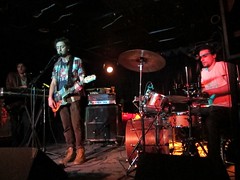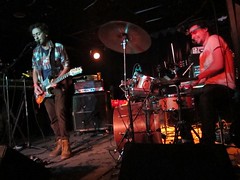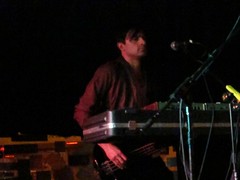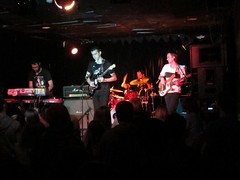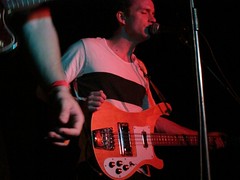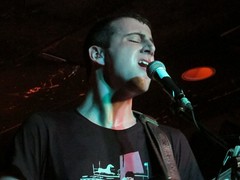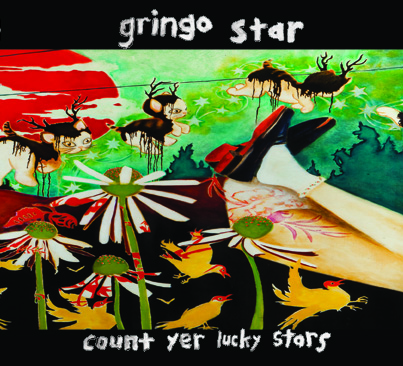25 October 2011 (Casselman's Bar, Denver CO)
Most of the hard hitting shows I've seen have been in dives. The Anvil concert at Casselman's Bar proved that an upmarket ambiance doesn't stifle a gritty rock experience. The venue had a comfortable front bar and a concert hall in back. Sure, the candlelit tables at the back of the hall were out of place for a metal show, but the roomy stage, high ceilings, and clean sound were a treat.
Between the incoming snow forecast and a slow Tuesday night, the turnout didn't begin to fill the big open hall. Opeth playing at the Ogden probably didn't help, either. Still, the smaller crowd was enthusiastic for the packed line up. A total of four bands warmed up the crowd for Anvil. The variety among the acts meant that fans could enjoy several flavors of metal in short 25 minute sets.
Side Effect
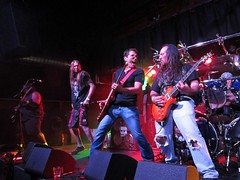
Side Effect kicked off the show a little before 8pm. It's all a matter of taste, but they were my favorite of the four opening acts. Their sound meshed best with Anvil's, with a good mix of grinding rhythm and throbbing bass. Their stage energy fit well, too, with a mix of fun and metal pose.
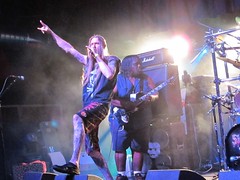
The lanky lead singer draped himself around the stage: perching a leg on a monitor to lean into the crowd or stalking back and forth. He worked the crowd, egging us on and sharing his enthusiasm for the music. The bass player tried to grab his share of the spotlight, goofing around and flashing his Gene Simmons-like tongue. That didn't stop him from keeping a constant drive going.
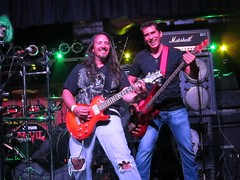
The two guitarists had the standard split of rhythm and lead duties, but they were well coordinated. They covered some good twinned rhythm parts to fill out the sound and also paired up on lead once in while. The main lead player had plenty of flash and great tone, while the rhythm player had a more focused sound, even on his occasional leads. The dual guitar sound was a bit like Judas Priest. Rooted in a classic heavy metal sound, their progressions were interesting.
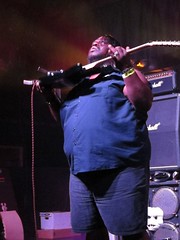
The drummer was hidden back in his cage, but laid down some great double kick rhythms. Side Effect played hard and focused but their stage vibe was relaxed and fun. That combination was a winner.
Elete
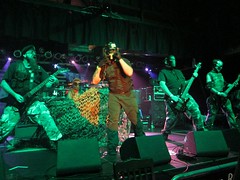 Elete
Elete took the stage with a strong visual presence. Paramilitary outfits and masks created a depersonalized stage presence. As the singer swaggered around the stage, the rest of the band focused on posing and projecting a strong, harsh attitude. It was a very theatrical vibe that matched the industrial metal sound of the music.
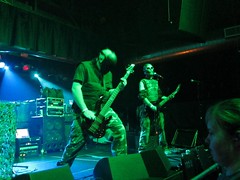
The band played along with a backing track of synthesizers and other electronic sounds. The dark grind of the music formed a setting for the singer's raspy voice and screamy punctuations.
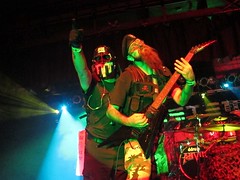
Live keyboards would have helped, but aside from the masks and makeup, Elete needed more
show. The high point was when the singer came out into the audience to hector the people lurking back at the tables and the rhythm guitar player lip synched to his vocals.
The Threatened
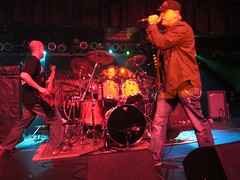 The Threatened
The Threatened dragged the audience back to classic heavy metal. The smooth vocal arrangements featured tight harmonies that pushed the sound to a more radio friendly direction. In stark contrast to Elete, the Threatened took the stage in their street clothes.
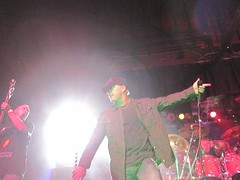
The opening song,
Savior featured a strong, chunky rhythm and a great bass solo. Later, the guitarist switched to a seven string guitar to shred out. Aside from the vocals, several of the songs had an early AC/DC grind.
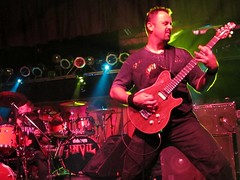
The best song of the set, though, was
Lose Control, which burst out with a great drum riff. While the band's playing was great, the drum work took it over the top. The verses featured some strong tom work, but the kick drum rolls were incredible.

The Threatened had a decent stage presence, moving around a bit. They needed more visual spark and more audience engagement to stand out in this crowd of bands.
Pressure Point
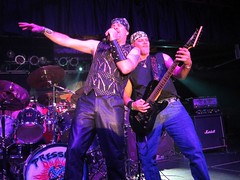 Pressure Point
Pressure Point knew all about visual spark. Rather than relying on their own charms, they brought in reinforcements. The show started out with a bit of theatre. A hot, bikini-clad babe walked the bass player onto the stage on a leash. Then another played roadie for the guitar player. The girls stayed on the stage to dance and act as eye candy. This explained Pressure Point's self-description as a rock a GOGO band.
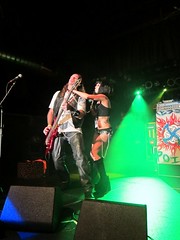
The bass player actually looked like he was having fun, but the rest of the band kept more serious expressions most the time. The guitar player pulled out some strong chops and the drummer kept up an assault beat driving the songs.
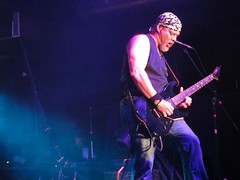
In spite of the pretty dancers and solid playing, Pressure Point's focus was the political message of the lyrics. Front man Kirk Young rapped and ranted his way through the set, raging at the government and conspiracies. He was more of a demagogue at a rally than a metal band singer. The vibe was mostly libertarian with a touch of tea party mixed in. I'll admit that I was a little uncomfortable with the swastika in their logo.

The unrelated mix of media and message made the set feel like propaganda.
Anvil
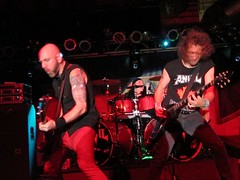
Before
Anvil took the stage, the lurking crowd finally filtered forward, filling out the front of the stage for the first time. A stronger turnout would have been nice, but Anvil seemed pleased as punch to play for us. That attitude is a big part of what made
Anvil! The Story of Anvil a successful documentary. It's clear that these guys truly love to play and perform. Their set showed off their strong personalities and featured a good balance between the theatrical and the music.
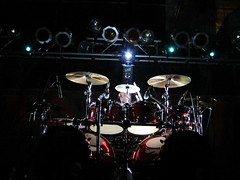
Drummer Robb Reiner spent the show hidden behind his immense kit, but he imposed his personality through his playing. The beats were heavy and in-time, but he never settled for simplistic. Instead he threw in constant fills and syncopation that provided a strong foundation for the guitar and bass. Late in the set, he finally got his chance for a real solo and was amazing. Double kick rolls and driving toms provided power, but his rhythmic change ups and dynamic shifts kept the solo interesting.
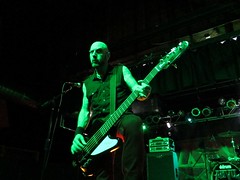
Bass player Glenn Five mostly maintained a serious look that wavered between disdain and maniacal, but every now and then he broke character and grinned at the crowd's enthusiasm. Even if his pose seemed aloof, his bass work was fully engaged. His spider fingers ran through the bottom end, then switched to a fist pound on the bass. Amazing chops, wicked stage persona, and charisma -- he had it all.
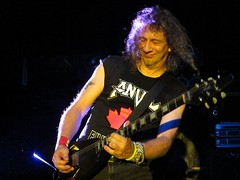
Guitar player Steve "Lips" Kudlow was the goofy counterpoint to Glen Five's attitude. Above all, his joyful stage presence made him seem boyish. He mugged for the crowd, taking every opportunity to strike a pose. His clowning had the perfect degree of self deprecation to invite the audience into his world. As the only one who really spoke, he provided the face of the band: a regular guy who's amazed to be doing what he loves.
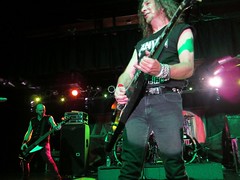
At the same time, Lips' playing was always exactly what the song needed from precise chops to bombastic leads. Like his clown persona, his flashy moves added to the show. Whether he was controlling feedback with precision or talking into his guitar like a microphone, he provided a show to match the music. During the extended solo on
Mothra, he pulled out a vibrator and used it to drive the pickups and then play slide guitar.
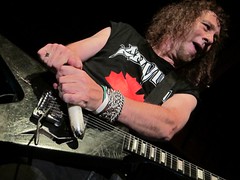
Anvil's sound was rooted in old school heavy metal. You could hear echoes of Black Sabbath and Motörhead, along with occasional flashes of Metallica. Most of all, it was just fun. They ended their set with a powerful version of
Metal On Metal. After a brief encore of
Running, the night was over all too soon. After
Anvil!, Anvil was sometimes called the real Spinal Tap. Last night's concert proved that they were much more than that - warm hearted, hard playing, and ass kicking.
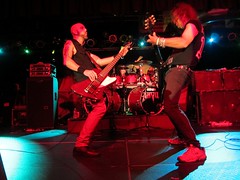
Many more photos on my
Flickr
 MUTEMATH may have some roots in Christian rock, but the band has made efforts to distance themselves from the segregated market niche that implies. On Odd Soul, the occasional lyric may reference spiritual matters, but the message is more about the music than the Good Word.
MUTEMATH may have some roots in Christian rock, but the band has made efforts to distance themselves from the segregated market niche that implies. On Odd Soul, the occasional lyric may reference spiritual matters, but the message is more about the music than the Good Word.
